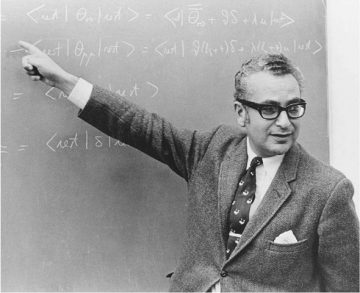Sheldon Lee Glashow in Inference Review:

I first encountered Gell-Mann in the spring of 1959, when he invited me to describe my work at a seminar in Paris. Having completed my Harvard thesis with Julian Schwinger, I was spending my first postdoctoral year in Copenhagen at what would become known as the Niels Bohr Institute. Gell-Mann was on sabbatical at the Collège de France. Not yet 30, he was already a renowned theorist. Among much else, he had explained the puzzling features of what were called strange particles. Gell-Mann proposed a new particle attribute S, which he called strangeness. He assumed it to be conserved by the strong nuclear force but not by the weak.1 Ordinary particles, like protons and neutrons, have no strangeness, whereas strange particles are variously assigned S = ±1 or ±2. They can be produced copiously by energetic particle collisions, but always two at a time and never singly. Their lifetimes are so unexpectedly long because their decays necessarily involve the weak force. Puzzle solved!
After my seminar, Gell-Mann invited me to a tête-à-tête dinner at a two-star Michelin restaurant, where I was cured of my lifelong aversion to fish as food. Gell-Mann seemed to appreciate my algebraic explanation for the universality of weak and electromagnetic coupling strengths. He presented my ideas, duly crediting me, at the 1959 International Conference on Elementary Particle Physics in Kiev, which I, being a mere postdoc, could not attend.
A year later, as my two-year National Science Foundation fellowship was running out, I was surprised and delighted to receive an invitation from Gell-Mann to spend a third postdoctoral year at Caltech. I accepted immediately: to learn from such luminaries as Richard Feynman and Gell-Mann, to enjoy California’s warm weather, and because I had few alternatives.
More here.
